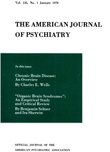MODERN METHODS OF ELECTROSHOCK THERAPY
Abstract
We have attempted to present in a somewhat chronologic form the growth and development of what we have termed a modern form of the application of electroshock therapy. It is well established that electroshock therapy benefits some psychiatric syndromes. We believe that by applying techniques now available this therapy may be applied safely with minimal complications, at the same time retaining benefits observed in its original form of application as well as, perhaps, additional ones. We have approached our objective—retention of therapeutic efficacy with the diminution of complications—by a series of stages or steps which, in retrospect, indicate that we elected to follow certain courses of action instead of others. We fully agree with Kalinowsky that electroshock therapy is made complicated by use of additional masking or modifying agents. We recognize that our use of sodium pentothal anesthesia is such a masking and complicating agent but justify its use because of the ability of the type of electrical equipment used to overcome the effect of the pentothal anesthesia if it happens that the operator uses more of this substance than is necessary. The very form of equipment we use is that which would be used were we treating a patient for respiratory cessation as a result of pentothal poisoning.
The utilization of electroshock therapy today implies concepts of objectives, neurophysiologic states, and avoidance of complications which formerly could be accepted as reasonable hazards. Pus, once regarded as laudable by surgeons, would now constitute malpractice. Similarly, "complications" of electroshock, as utilized originally, no longer find adequate defense in modern treatment. Judiciously applied to selected cases for particular purposes, electroshock has reached a state of therapeutic acceptance. Its application as a panacea for all psychiatric syndromes in a "routine" manner is injudicious and may be hazardous. Modern electroshock therapy implies the utilization of both technical skills and clinical acumen in making the treatment less hazardous than the disease. Electroshock is a valuable tool; it can be a dangerous weapon.
Access content
To read the fulltext, please use one of the options below to sign in or purchase access.- Personal login
- Institutional Login
- Sign in via OpenAthens
- Register for access
-
Please login/register if you wish to pair your device and check access availability.
Not a subscriber?
PsychiatryOnline subscription options offer access to the DSM-5 library, books, journals, CME, and patient resources. This all-in-one virtual library provides psychiatrists and mental health professionals with key resources for diagnosis, treatment, research, and professional development.
Need more help? PsychiatryOnline Customer Service may be reached by emailing [email protected] or by calling 800-368-5777 (in the U.S.) or 703-907-7322 (outside the U.S.).



